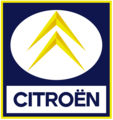Citroën
Citroën (French pronunciation: [sitʁɔɛn] )[note 1] is a French automobile brand. The "Automobiles Citroën" manufacturing company was founded in 4 June 1919 by André Citroën. Citroën has been owned by Stellantis since 2021 and previously was part of the PSA Group after Peugeot acquired 89.95% share in 1976.[5] Citroën's head office is located in the Stellantis Poissy Plant in Saint-Ouen-sur-Seine since 2021 (previously in Rueil-Malmaison) and its offices studies and research in Vélizy-Villacoublay, Poissy (CEMR), Carrières-sous-Poissy and Sochaux-Montbéliard.
Company type
4 June 1919
Worldwide, except:
- North America
- North Korea
Carlos Tavares, CEO Stellantis
Thierry Koskas, CEO Citroën (since 23 February 2023)
Citroën Insurance
13,900[4]
In 1934, the firm established its reputation for innovative technology with the Traction Avant.[6] This was the world's first car to be mass-produced with front-wheel drive, four-wheel independent suspension, as well as unibody construction, omitting a separate chassis, and instead using the body of the car itself as its main load-bearing structure.[7]
In 1954, they produced the world's first hydropneumatic self-levelling suspension system;[8] then the revolutionary DS, the first mass-produced car with modern disc brakes, in 1955;[9] and in 1967 they introduced in several of their models swiveling headlights that allowed for greater visibility on winding roads. These cars have received various national and international awards, including three European Car of the Year awards.
Some joint venture models are manufactured in third party or joint venture factories, including the following:

















